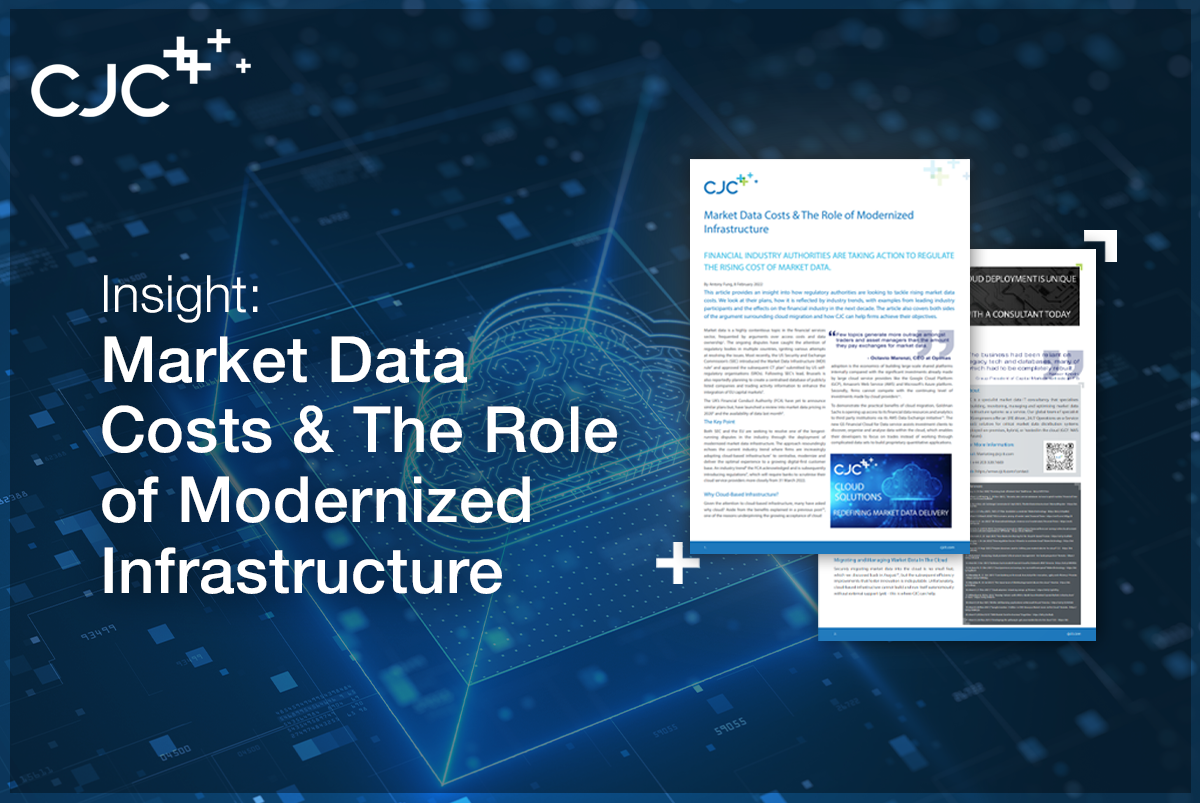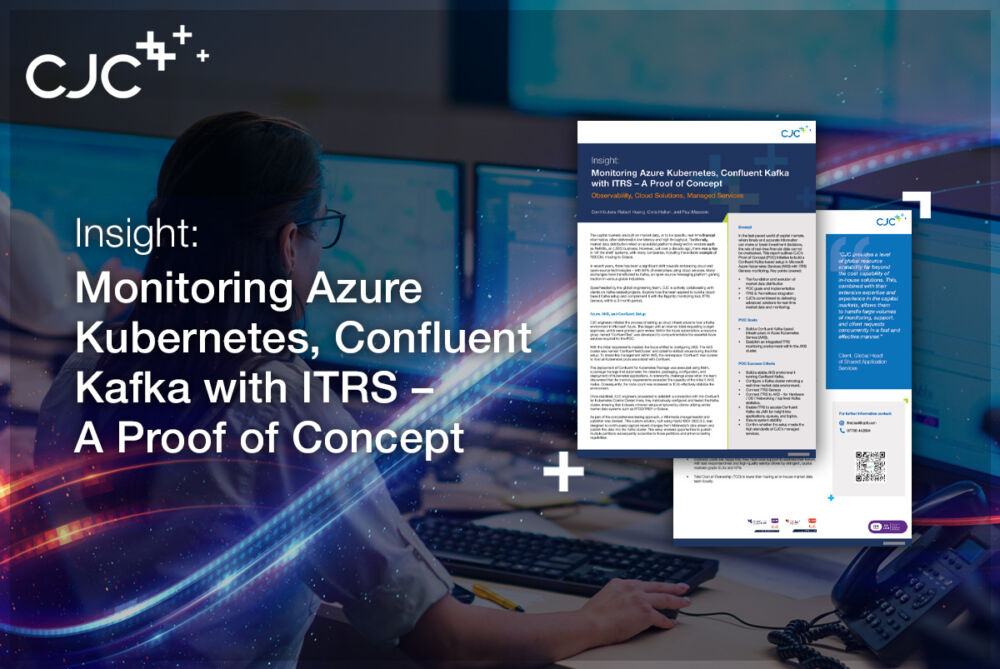Get notified of the latest news, insights, and upcoming industry events.
Metaverse Market Data – Thought Leadership by Steve Moreton
Speaker
- Steve Moreton, Global Head of Product Management at CJC Ltd.
At the 2023 FISD Netherlands event hosted by Rabobank on January 25, Steve Moreton, Global Head of Product Management at CJC, presented the first FISD topic around the ‘Metaverse’, with focus on introducing the concept, technology, and implications on market data and the capital markets.
What is the Metaverse?
Backed by Meta and Microsoft, firms are making long term and strategic investments into the Metaverse – a stimulated 3D environment that uses AR, VR, and blockchain, to replicate the real-world for immersive user interaction. Many are looking to have the same impact as the smartphone, to change the way we touch technology, data, communicate, collaborate, socialise, and shop.
Right now, it has little to do with market data. However, at the 2022 World Financial Conference (WFIC), LSEG and SIX stated that firms needed to start to roadmap to the metaverse. Some advancements being made will have impact soon – let’s look at why.

What could the Metaverse mean for market data and the capital markets?
The rumbling, yet seismic, upcoming event is the advent of the metaverse version of Microsoft 365 through their partnership with Meta. Windows, Office, Excel, and Teams are critical OS and applications for the capital markets. Most major market data applications run on Windows, and it goes without saying that Excel is still a vital tool for the financial services.
Collaboration – stimulating a face-to-face meeting with Microsoft Teams and Meta Workrooms
 Collaboration and communication is the glue of any organisation and industry, in which the metaverse is the evolutionary next step in communication. In the image (say where), this is as close as a face-to-face meeting in the metaverse. For each user, you can see, hear, and to some degree, shake hands and draw on whiteboards. Some argue that this can be done on Zoom, however, web conferences lack non-verbal communication. The metaverse delivers nonverbal communication in spades, with all its hand articulation, head tilts, etc.
Collaboration and communication is the glue of any organisation and industry, in which the metaverse is the evolutionary next step in communication. In the image (say where), this is as close as a face-to-face meeting in the metaverse. For each user, you can see, hear, and to some degree, shake hands and draw on whiteboards. Some argue that this can be done on Zoom, however, web conferences lack non-verbal communication. The metaverse delivers nonverbal communication in spades, with all its hand articulation, head tilts, etc.
Collaboration is seen as the ‘low hanging fruit’ of metaverse, something all firms can leverage and start to achieve benefits. However, collaboration also builds firms’ population in the metaverse. Population is an important factor in a firm’s metaverse journey. Without population, it may create issues when trying to place a companies’ actual products and services to the metaverse itself.
Microsoft 365 in VR
The arrival of Microsoft 365 means any application working in Windows, will now work in the metaverse, including market data applications. Vendors such as Bloomberg, LSEG Refinitiv, FactSet, along with all the internally written market data apps, all use this OS. Therefore, their applications will be lifted and shifted to the metaverse.
 The ‘lift and shift’ of market data apps brings some immediate benefits. Just looking at the screenshot of Microsoft 365, the user has decoupled from the concept of the screen. What looks like 5 screens, are purely applications. The whole environment is now desktop real estate. For market data applications, this provides unlimited access to what the products can do, including users on trade floors who have 4-12 screens on their desks.
The ‘lift and shift’ of market data apps brings some immediate benefits. Just looking at the screenshot of Microsoft 365, the user has decoupled from the concept of the screen. What looks like 5 screens, are purely applications. The whole environment is now desktop real estate. For market data applications, this provides unlimited access to what the products can do, including users on trade floors who have 4-12 screens on their desks.
As mentioned, firms have options to place their products and services fully into the metaverse and enable its features fully.
Placement of Products and Data to the metaverse
For a market data vendors they have the following options to place their products and services into the metaverse. Using Bloomberg as an example, let’s look at their options.
Mock-up of a metaverse augmented reality Bloomberg experience, with 3D data
Bloomberg market data application has been running in Windows for decades. There is nothing to stop Bloomberg making their application available to the metaverse. A full, virtual office, with at least 8 screens and the option to leverage collaboration. Users could summon Bloomberg trainers to assist them as ‘avatars’. Customers would also meet internal/external parties here as avatars. This is where the initial collaboration aspect of the metaverse is important. By building ‘population’, the placement of these features is enabled.
Market Data 3D
 Market data has traditionally been viewed as 2D images. The metaverse can show this data in an unrestricted way from the desktop size, providing users the ability to zoom in, spin, and interact with data in a manner never seen before.
Market data has traditionally been viewed as 2D images. The metaverse can show this data in an unrestricted way from the desktop size, providing users the ability to zoom in, spin, and interact with data in a manner never seen before.
The Future?
The projections made thus far have been based on what VR can do today and in the next year. However, let’s do some out of the box thinking, albeit based on research.
ESG data, The Metaverse, and Digital Twins
Digital Twins are as important to ESG data as it is to the Metaverse.
Digital twins are considered “the foundation of the enterprise metaverse”. Equally, Digital twin technology is an innovative tool for companies to help hit their Environmental, Social and Governance (ESG) and sustainability goals.
 A digital twin is an object that exists in the real world, such as, a wind turbine. The wind turbine has sensors on it which provides a multitude of data from its operation, speed, energy generated, etc. All data is sent to the internet/metaverse to a ‘digital twin’ – a virtual recreation of the wind turbine which is running in parallel. Move on from 1 wind turbine – what about a whole city full of wind turbines and digital twins of buildings, public transport, weather, temperature, traffic? To some this may sound unrealistic – but it’s 100% real.
A digital twin is an object that exists in the real world, such as, a wind turbine. The wind turbine has sensors on it which provides a multitude of data from its operation, speed, energy generated, etc. All data is sent to the internet/metaverse to a ‘digital twin’ – a virtual recreation of the wind turbine which is running in parallel. Move on from 1 wind turbine – what about a whole city full of wind turbines and digital twins of buildings, public transport, weather, temperature, traffic? To some this may sound unrealistic – but it’s 100% real.
Singapore – the world’s first digital twin city
Singapore has led the world in digital twin technology, designed for metaverse and VR use. The key driver for the tech is to improve the future: achieve sustainability goals, improve city experience, reduce crime, efficient urban planning, and measuring environmental data – datasets of which are an ESG analyst playground.
Digital Twin Cities are to Yield US$280 Billion in Cost Savings By 2030 alone, therefore, becoming one of the biggest trends in the metaverse. Digital twin cities are being created all over the world, including Shanghai, New York, Florida, and Helsinki.
For more information, contact us or:
Email: [email protected]
Tel: +44 203 328 7600
Get In Touch
your market data ecosystem!



















